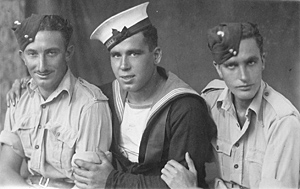
My Six War Years - June 26 1940 - June 26 1946 |
By John F. Osborne As Told To Mary S. Osborne |
1941
We also shipped aboard Norwegian, Estonian and Greek cargo ships and Belgian, Dutch and English fishing trawlers. At first I suffered badly from seasickness which was cured by a suggestion from a Norwegian skipper to sit on the deck with my knees tight under my chin even on watch.
On one Norwegian ship a large German plane attacked us, and Taffy, who was on watch, opened fire with his machine gun, but the plane disappeared in cloud cover. Another time Taffy shot 50 rounds of ammunition to sink a floating mine. When I applied at the shore base for more ammunition the officer was unbelieving that we had used such a quantity!
 |
In late 1941 Taffy and I were sent to Swansea, Wales, to join a ship sailing to Sierra Leone, West Africa, sailing in convoy. There we were billeted ashore to wait for a ship back to England. The ship we had just left sailed out of Sierra Leone and was sunk by torpedoes with all hands lost. The ship owners did not know that Taffy and I had left the ship.
We returned to England on a different ship in a convoy concealing heavy battleships. This was for protection from the German battleship Bismarck, which was preying on Atlantic shipping and had just sunk the H.M.S. Hood, the pride of the British Navy. Shortly after this the Bismarck was torpedoed and sunk by the Navy in the North Atlantic.
Arriving back in England, I went home on leave, then reported to Bristol, our new headquarters. Instead of being assigned to D.E.M.S., which was Royal Navy, my group was now the 6th Regiment Maritime Royal Artillery, a British Army unit.
1942 "Not REALLY Dead!
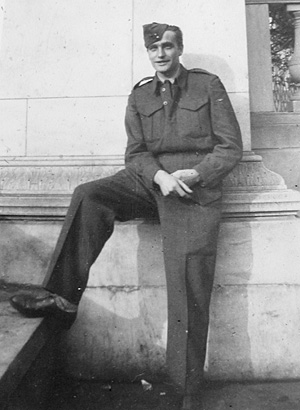 |
In the spring of 1942, Taffy and I were assigned to an Estonian cargo ship sailing from Swansea, Wales, to St. John, New Brunswick, Canada. On board I contracted trench mouth from the unsanitary kitchen and had to remain in the hospital in St. John until cured. Taffy had shipped out so I went by train to Sidney, Nova Scotia, where I was billeted at a Canadian Army barracks. There I was able to replenish my worn uniforms with Canadian equipment.
Next I traveled by train to Halifax, Nova Scotia to serve on an English ship returning to England. When arriving home on leave, I had to open the window of our house with my sheath knife as the door was locked. Our next door neighbor pounded on the door saying, “Open up, Johnny, I know you’re in there!” When I opened the door he said, “Where did you meet your Waterloo?” This question was a mystery until my mother came home. She somehow sensed that I was there inside, and showed me a “Missing in Action” cablegram she had received. The ship that had carried me to Sierra Leone W.A., had been sunk outward bound and no one knew that I had sailed on a different ship. My mother said she never had believed that I was lost.
I then returned to Bristol where I met the company Sgt. Major who was interested in what had happened to me. During our conversation I said, “You at home don’t know me, where I have been or what I have done or seen”. He answered that they knew all about me so I asked him to explain the telegram my mother had received. Also that she had contacted the Red Cross and other organizations and was told nothing. She had contacted the Military with no results. I handed him the telegram, he took it but said nothing and left. I never saw him or the telegram again.
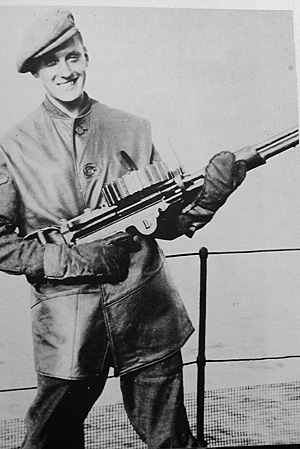 |
While still billeted in Bristol the next day I was teamed with Fred Childs, and we served together for over a year. Next we were sent to Falmouth, Cornwall, to defend fishing vessels. One summer day when Fred and I were both off duty, we planned a picnic with two Belgian girls on a cliff overlooking the ocean. A member of a gun crew reported sick, so Fred was teamed with another gunner on a Dutch trawler, leaving the girls and I to climb the cliffs without him. From the cliffs we had a perfect view of two German planes attacking the trawler. Fred held a machine gun, the ship’s sole defense, up to his shoulder, and fired at the planes. One was hit and disappeared into the ocean and sank, the other flew away. For this feat Fred was called to Buckingham Palace to receive a medal and letter of commendation from Queen Wilhelmina of The Netherlands. This award will appear in a later adventure.
After we again reported to headquarters in Bristol, we were assigned to the S.S. Umberleigh. She was an old tramp steamer, which was at the breaker’s yard when war broke out. Instead of being wrecked for scrap she was recommissioned and loaded with cargo of tanks and ammunition for Alexandria, Egypt. The ship’s top speed was five knots and her only defense was a 3” surface gun mounted on the stern and manned by two naval gunners. Fred and I shared a machine gun for air defense, as the surface gun could not point above the ocean. Each trip the Umberleigh made out of port we had fresh food and water for three days. Without refrigeration and with only small water storage, we then ate canned food and rationed our water use until we docked again. Each crewmember received a small bucket of fresh water per day for all use and the faucets were then locked. For laundry and bathing we used salt water.
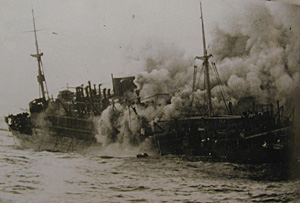 |
It was too dangerous to sail to Egypt via the Straits of Gibraltar and the Mediterranean Sea so we progressed south down the West Coast of Africa through the Atlantic Ocean. We encountered a hurricane while still in convoy, causing the cargo to shift and tanks to break away in the hold. Enormous waves rolled across the bridge. When the convoy reformed after the storm, the ship to the stern of Umberleigh blew up from a torpedo strike. We saw a huge explosion and did not know if there were survivors.
After proceeding without escort around the Cape of Good Hope, through the Indian Ocean and the Suez Canal, we arrived in Alexandria, Egypt. T he city was full of troops as we unloaded the cargo for General Montgomery and El Alamein. The next day the city was empty of troops, as they had all been transported to the desert to win the first important Allied victory.
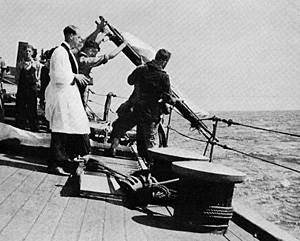 |
We then steamed back toward the Atlantic Ocean via the Suez Canal and the Gulf of Aden, as the Mediterranean Sea was full of U-boats (German Submarines). In the Indian Ocean a seaman died of typhus. After a brief sermon by the captain he was thrown overboard. The sharks, which had been following us, disappeared.
We progressed south along the East Coast of Africa to Laurenco Marques, Portuguese East Africa, Uruguay, in South America.
While in port one evening Fred and I went ashore with two of the crew. We stopped at a nightclub for a drink. The third mate of the Umberleigh, who was in charge of the gun crew, was at another table, and a few words were exchanged between us about watches in port. We told him that we had never been ordered to do port watches. Shortly after, the night club manager came to our table and told us that our two Naval gunners were outside looking for us. He said they could not come in because they were not properly dressed. Fred and I went outside. The gunners were not there but four native policemen stopped us from going back in and started hitting us with nightsticks. I got away but Fred was arrested and spent the night in jail. The next day the skipper got him out.
Our next stop was Durban, South Africa, where our two naval gunners jumped ship. While in Durban, Fred and I went to town for the evening to have a few beers. Somehow I got separated from the others and had to make my own way back to the ship, which was sailing at 1 A.M. at high tide. To get to the docks I had to walk, and was advised not to do this. Evidently it was a bad area but I had no choice. I walked down the center of the road feeling pretty scared. I had nearly reached the gate of the docks when I heard someone behind me. On turning, I saw a very large black man with something like a shovel in his hands. I didn't wait but ran for the gate. There were two guards on duty with rifles but the man behind me was gone. The guards said I was crazy to walk down that road alone at night. They let me through the gates and I got to the ship just in time. She was about to sail and I got to the ship, as she was about to leave.
We stopped in Port Elizabeth to replace the two missing gunners, then proceeded around the Cape of Good Hope to Capetown to pick up supplies. We crossed the South Atlantic unescorted by convoy to Montevideo, Uruguay.
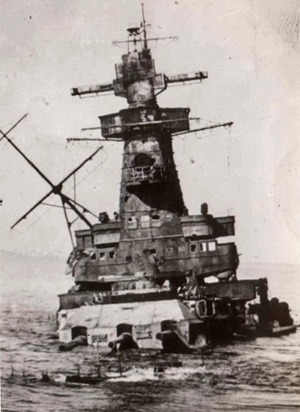 |
While on watch en route, the skipper of the Umberleigh called my attention to a ship on the distant horizon. Strangely, she was sailing slightly above the horizon! It was a mirage of our own ship caused by heat waves. Outside the port, was the German battleship Graf Spey which had been scuttled by her crew in 1940 to escape the British Navy.
Argentina, Brazil and Uruguay were neutral countries in the war and when ashore we were supposed to wear civilian clothes. Fred and I dressed in uniform to go ashore and attended a cookout picnic given by the British Consulate. They roasted a whole sheep on a spit over an open wood fire and we also met the consulate’s staff.
After unloading the coal into barges, we steamed up the River Plate to Rosario, Argentina. On the way the crew and we gunners cleaned the hold so it could be filled with grain to return to England.
Next, we proceeded to Buenos Aires, Argentina. Here the third officer on the Umberleigh charged Fred and I with “dereliction of duty” before the head British naval officer there. He was in civilian clothes because of Argentina’s neutrality. We were accused of not appearing in time to stand our port watches. After hearing the third officer, he asked if there were any extenuating circumstances. I said, “Fred, show him your letter from Queen Wilhelmina”. Reluctantly, Fred pulled it out and showed it to the officer, who said, “Case dismissed!”
The Umberleigh then left, bound for England with the load of grain. Our first stop was Trinidad, British West Indies, in the Caribbean Sea. I was given a shore job teaching gunnery to merchant seamen. When I requested to return to active duty after a short time, the officer said “But you could get killed out there!”
Fred had left on the S.S. Umberleigh, so I joined a new guns crew on the M.V.Empire Bronze, an oil tanker bound for Accra, Gold Coast, now Ghana, in Africa. We unloaded and returned to Bahia, Brazil, now Salvador.
Halfway across the Atlantic I became very sick with typhus. Upon arrival in Bahia, I was hospitalized for several weeks, then boarded in a local inn or “pension” to recover. While sick in hospital I could not digest the spicy food so the doctor suggested putting catsup on it! I soon recovered my appetite.
After recuperating, I signed on the M.V.Cistula with a different gun crew. I was surprised to find that the third officer on the Umberleigh, who had charged Fred and me in Rosario, was on the ship and was promoted to first officer. One of the sailors and I went ashore to a party, and as the first mate had not told us when we were joining the convoy, we nearly missed the sailing. The British Vice Consul saw us standing on the dock and took us to the ship in a motor launch. The Cistula was already under way and we had to climb a long rope ladder to get on board. Standing on the bridge was the first mate, but this time he made no comment.
Next: 1943